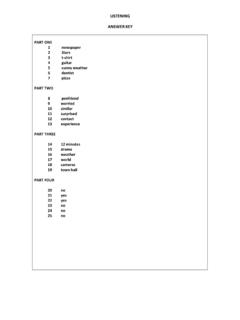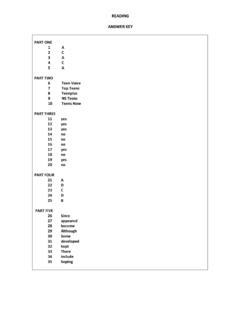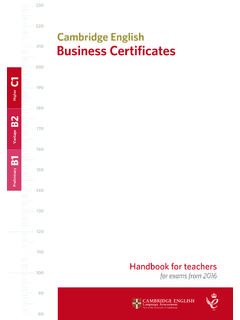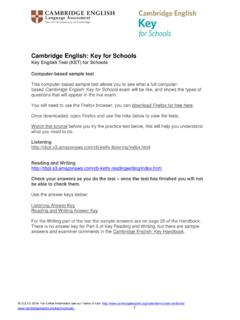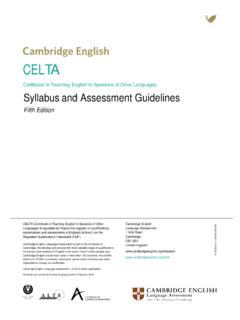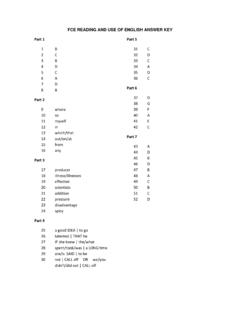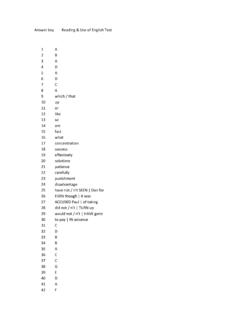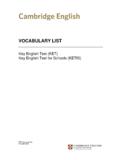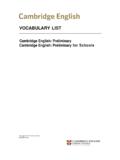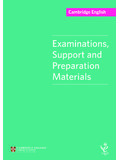Transcription of Classroom warmers activity booklet
1 Classroom warmers activity booklet This booklet includes seven exercises each for primary, lower secondary and upper secondary students.. Contents Primary Upper secondary 1. Animal 4 1. Don't say 25. 2. Teacher 2. Yes/No 26. 3. Draw 3. Alphabet 4. Quiz: How many?.. 8 4. Just a 29. 5. 5. Two true, one 30. 6. Kim's 11 6. 32. 7. Virtual ball 7. Questions 33. Lower secondary . 1. Think of five 2. 3. One-word 4. Correct 5. Compare 20. 6. First letter, last 22. 7. Sentence 23. 2 3.. 1. Animal mimes 2. Teacher says PRIMARY. PRIMARY. Description Description Students mime animals for each other to guess. Students listen and move according to the teacher's instructions. This is similar to Simon says, but students need to listen carefully and do what you say (not always what you do!). Time required: 10 20 minutes Time required: 10 15 minutes (Optional) animal pictures . Materials required: you could use the Pre A1 Starters flash cards Materials required: None To engage students with a fun, physical activity To engage students with a fun, physical activity Aims: Aims: To review animal vocabulary To review parts of the body and action verbs Procedure Procedure Model the activity .
2 Say: What animal am I?' Choose an animal and mime it, making the Model the activity . Say: Listen. Do what I say.' Give some simple instructions and show the .. animal noise if you like (younger children will enjoy this!). When someone guesses it, say corresponding movements at the same time. See examples below. Well done! It's your turn!' Ask them to choose an animal (or give them an easy one to mime and make the noise if they want (lion for example) for the rest of the class to guess. Now say: Listen carefully. Do what I say.'. Point to your head, but say: Point to your hand.' If students point to their heads, repeat the Divide students into groups of 4 8, according to where they are sitting. instruction, until they all point to their hands. Students take it in turns to choose their own animals Continue playing the game, encouraging children to listen carefully. Sometimes make the to mime for the rest of their group.)
3 Action the same as your instructions, and sometimes make it different for example, say Confident students can mime for the Hold up one finger' but hold up two. Keep it light and fun it's not a test and part of the fun whole class. is that it's difficult to follow a spoken instruction that is different from the action you see! To add challenge, students could Example instructions: Use vocabulary your students are familiar with. describe the word to give extra clues. For example, for cat they could say Four legs', Point to your [nose/head/eyes, etc.]. It eats fish' or It is a pet'. Hold up [2] fingers. Show me your [hands/fingers, etc.]. For extra support, you could display animal Stand up. flash cards on the board and elicit the animal Sit down. words first, helping with words children find difficult to pronounce. You could give a To add challenge, you could make your instructions more difficult, for example, Clap your student an animal to mime if they struggle to hands five times'.
4 You could use more challenging vocabulary, for example: chest, stomach, think of one by themselves write it on a piece neck, nod/shake your head, smile, wave, etc. of paper or show (don't give) them an animal flash card so no one else can see.. Alternatives: You can use this activity to revise other lexical sets which can be mimed, for example jobs, sports, adjectives, hobbies. 4 5.. 3. Draw it Older, more confident children can take it in turns to lead the activity for the rest of their group. First play the game as a whole class, as above. Then divide them into groups of 4 8, according to where they are sitting. Ask students to take turns to give instructions. They play the game with their group. PRIMARY. PRIMARY. For extra support, you could review parts of the body and action verbs first. Point to different parts of your body and ask What's this?' Elicit the words, model and drill for Description pronunciation.
5 Do the same with the action verbs, for example, point to your head: What's Students draw pictures to help other children to guess words. this?' (head) Point to your head' (demonstrate by pointing to your head and encourage students to copy you). Time required: 10 20 minutes You could simplify the activity , by playing the game simply as Teacher says': children only Follow the guidelines set by your school for the safe distribution and use copy you if you say Teacher says '. For example, if you say Put your hand on your head'. of Classroom resources and materials: they should not move, but if you say Teacher says stand up' they should stand up. 1. Student notebooks Materials required: 2. Felt tips or marker pens for each child Alternatives: You can use this activity to revise other lexical sets such as colours Point to 3. Mini whiteboards (blank paper in a plastic sleeve) that can be wiped something blue/red/grey' or prepositions Point up/down'.
6 Clean 4. A4 or A3 scrap paper To engage students with a fun group activity Aims: To review vocabulary (for example, food, animals, furniture, hobbies).. Procedure Divide students into groups of 4 8, according to where they are sitting. Demonstrate the activity with the whole class first by drawing a simple picture on the board for children to guess (for example, an apple). In each group, ask for a volunteer. Show a word to the volunteers make sure it's a word they know, and can easily draw. Don't let any of the other students see the word. Say: Don't say anything. Draw it.' They draw a picture on their notebook/mini whiteboard/scrap paper, and show it to their team-mates to guess the word. The group which guesses the word first wins a point. Then choose a different volunteer in each group. You could use this to review food, Classroom objects, furniture, or other words children know that are easy to draw.
7 To add challenge, use more difficult words, or phrases. For example, jumping, rain, a happy cat, a thin man. Or, let students lead the activity and choose their own words for their team- mates to guess. For extra support, tell students the topic (for example, food). Write four or five words on the board for children to choose from when they are guessing. 6 7.. 4. Quiz: How many? Then, count down Three, two, one, show me!' The children hold up the numbers they wrote at the same time. Confirm correct answers (depending on the questions, answers might be different for different groups). Move to the next question. PRIMARY. PRIMARY. Choose questions according to the level of your students. Examples: Description Easier questions Students answer questions that involve counting. How many children/girls/boys are in More challenging questions your group? How many legs does a cat/do two dogs/.
8 Time required: 10 20 minutes How many pencils/pens/bags are on cats have? your table? (Optional) numbers flash cards you could use pages 42 43 in Pre A1 How many eyes/noses/hands are there Starters flash cards How many fingers/eyes/feet have you in your group? got? Plus, other questions based on what all Materials required: One student in each group uses their own notebook and felt tip or How many clocks/doors/people are the children can see. marker pen to write the answers there [in the Classroom ]? If you do this as a whole-class activity , each student should use their own notebook and pen to write To add challenge, students could try asking their own How many?' questions. Include higher numbers, up to 20 (or higher, if your students know them). To engage students with a fun, collaborative activity Aims: To review numbers For extra support for younger, lower level students, you might want to review numbers first use flash cards to elicit and check understanding.
9 Model and drill the numbers. Ask children to count to 10. Check understanding by holding up your fingers and asking How . Procedure many?' When you check answers to the How many? questions, encourage the children to count together: How many heads are there in your group? Let's count. One, two, three, four. Four heads!'. Ask a couple of simple How many' questions for the whole class to answer. For Alternatives: Do this as a whole-class activity . All the children hold up the numbers they example, you could ask what they can see in the Classroom : How wrote at the same time. many teachers are there?' (one) How many windows are there?'. Divide students into pairs or groups of 3 4, according to where they are sitting. Say: Who will write?' Make sure they have writing materials (see Materials required). Display How many?' questions on the board, one at a time. Say: Work together. Write your answer.
10 ' Give students a little time to think, discuss and write the answer on their scrap paper or mini whiteboard. Make sure they write their number nice and big. You could show a countdown timer.. 8 9.. 5. Anagrams 6. Kim's game PRIMARY. PRIMARY. Description Description Students unscramble letters to make words. Students try to remember and identify missing objects. Time required: 10 15 minutes Time required: 10 20 minutes Follow the guidelines set by your school for the safe distribution and use Flash cards of Classroom resources and materials: Pre A1 Starters flash cards 1. Student notebooks A1 Movers flash cards Materials required: 2. Felt tips or marker pens for each child A2 Flyers flash cards Materials required: 3. Mini whiteboards (blank paper in a plastic sleeve) that can be wiped Or real objects (providing all the children can see them), a tray to hold clean them and a cloth to cover them 4.
